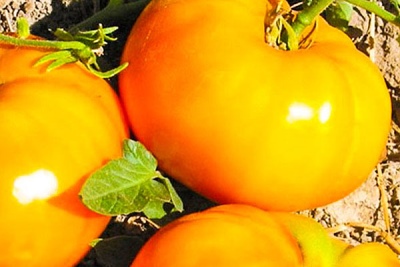
- Category: grade
- Growth type: determinant
- Appointment: fresh consumption
- Ripening period: mid-season
- Ripening time, days: 110-120
- Growing conditions: for open ground, for film greenhouses
- Bush size: undersized
- Bush height, cm: 70-100
- Ripe fruit color: bright yellow
- Fruit shape: rounded, slightly flattened
Yellow tomato varieties have a sweet taste. The Golden Queen tomato is no exception.
Description of the variety
The Golden Queen variety belongs to determinant crops, that is, it has a limited growth force. The average height of the bush is 70-100 cm.
The stem is strong, thick and well developed. Many gardeners recommend pinching the top of the crown, since the culture will spend all its strength and useful minerals on growth, and not on the formation of fruits.
Leaves are medium, rich green, with slight pubescence. The plate has a characteristic midsection and veins. There are large notches along the edging. From severe drought and sunshine, leaves can curl up.
It is recommended to form 2 stems. The first inflorescence is formed at the 6-7 leaf level. From 3 to 4 fruits ripen on one bunch.
The positive aspects include:
- ripening terms;
- yield;
- storage periods;
- transportation;
- taste qualities.
Among the shortcomings, we can note the need to form a bush and tie it up.
The main qualities of the fruit
The fruits of the Golden Queen are large and flat-round in shape. The weight of one tomato can reach up to 700 g. This refers to the very first ripe fruits. Subsequent vegetables will weigh from 300 to 500 g.
The rind is smooth and firm, does not crack. The peduncle has a characteristic ribbing. The color of ripe fruits is bright yellow or bright orange.
The pulp is fleshy and juicy, with a moderate density, not watery. 1-2 narrow longitudinal chambers with medium-sized seeds are formed inside. The pulp is white-yellow in color.
Fruits can be canned, dried and pickled. And also the variety is suitable for fresh consumption.
Taste characteristics
There is a sweet, delicate taste with unobtrusive fruity notes.
Ripening and fruiting
The Golden Queen tomato belongs to mid-season crops with a ripening period of 110-120 days. Although the fruits are formed at the same time, fruiting is long, and occurs from July to August. Therefore, on one brush there can be fully ripe fruits and those that are just gaining color.
Yield
If all agrotechnical points are observed, 9-12 kg of tomatoes can be harvested from 1 m2.
The timing of planting seedlings and planting in the ground
Before sowing, special seedling boxes are harvested. The soil for them can be purchased or prepared in the fall. The earth in the boxes is spilled abundantly with water and shallow holes are formed.
The seeds are soaked in water and then treated with potassium permanganate solution. After sowing the seeds, the soil is moistened again, covered with foil and removed to the windowsill. The average room temperature should be +18 degrees. The seeds will hatch in a week. The film can then be removed.
Water the seedlings with a spray bottle. After the seedlings have formed several leaves, it can be dived.
If slow growth of the stem is noticeable, then it lacks sunlight. In this case, it is necessary to additionally install a UV lamp.
In early May, the seedlings are taken outside for acclimatization. When transplanted into the ground, the plant should form 6-7 leaves and 1 flower cluster.Exact pick-up times vary. It depends on the growing region and on where the crop will grow (indoors or outdoors). Seedlings are planted in the soil approximately 50-60 days after the seeds have hatched. The daily air temperature should be at least +16 degrees.

Growing tomato seedlings is an extremely important process, because it largely depends on whether the gardener will be able to harvest at all. All aspects must be taken into account, from seedbed preparation to planting in the ground.
Landing scheme
Before planting, the soil is dug up and spilled abundantly with water. The pits are dug shallow, only 15 cm. At the bottom of the pit, ammonium nitrate can be poured to stimulate growth and greenery.
The best planting scheme is when 3-4 bushes are planted per 1 m2. On average, a distance of 50x50 cm is obtained between them. Subsequently, this will help in processing seedlings and harvesting, since the bushes will not interfere with each other.

Growing and care
For a good harvest, it is important to follow some rules.
- It is necessary to draw up a watering schedule. The first watering is done two weeks after planting the seedlings in the ground. The main feature is that the water should only fall on the root. If you water the leaves, then there is a chance of developing fungal diseases.
- Sonkeeping should be done every week. You can use pruning shears or garden shears.
- Once a week, it is necessary to loosen the soil around the bushes to supply oxygen to the root system. Weeds are removed during loosening.
- Top dressing is best done several times per season. Nitrogen stimulates the growth and production of green pigments. During ovary and fruiting, it is better to use phosphorus and potassium.




A plant needs different micronutrients at each stage of growth. All fertilizers can be divided into two groups: mineral and organic. Folk remedies are often used: iodine, yeast, bird droppings, eggshells.
It is important to observe the rate and period of feeding. This also applies to folk remedies and organic fertilizers.
Disease and pest resistance
The most common tomato disease is late blight. Plants are infected with the fungus through the soil in an environment that is too humid. The disease progresses quickly and destroys most of the crop in the shortest possible time. To avoid late blight, spraying with garlic infusion is used for prophylaxis.



























































































